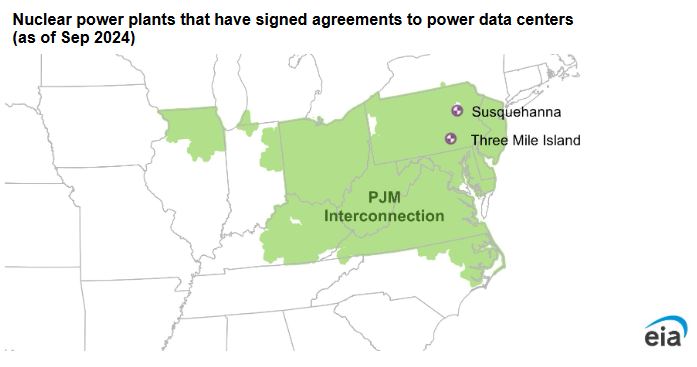Last month, Constellation Energy announced a 20-year power purchase agreement (PPA) to provide electricity to Microsoft data centers in the mid-Atlantic region from the Unit 1 reactor at the Three Mile Island nuclear power plant in Pennsylvania.
Unit 1 had returned to operation in 1985 after the 1979 partial meltdown that affected the adjacent Unit 2, but it was retired in 2019 because then-operator Exelon said it was no longer profitable.
The arrangement is the second this year in which a nuclear power plant owner has agreed to supply a data center with dedicated power as data center owners look for large and reliable sources of electricity supply for planned increases in demand. In March, Amazon Web Services (AWS) signed a contract for 960 megawatts (MW) of capacity from Talen Energy’s Susquehanna nuclear power plant in Pennsylvania. Both plants are in the PJM transmission organization.
What makes nuclear power plants attractive to data center owners?
Although historically costly to build, nuclear power plants typically generate power at relatively low operating costs, with a single reactor generally having a capacity of 800 MW or more. Nuclear power plants also produce electricity without directly emitting carbon dioxide, a consideration for technology firms investing in energy-intensive data centers that are trying to meet self-imposed emissions reduction goals.
Data center electricity demand doesn’t fluctuate during the day in the same way as demand from residences or many other businesses. Instead, data center operators typically require a consistent and steady supply of electricity at all hours. Likewise, nuclear power plants operate continuously, and they have difficulty ramping up and down to match variable demand.
The consistent generation from nuclear power plants will ensure that a data center has access to sufficient electricity around-the-clock, while also providing access to a large source of CO2 emission-free power.
How much do these recent power purchase agreements tell us about data center demand?
Although the two agreements underscore that data center operators are in search of large sources of emissions-free electricity, future electricity demand from data centers is subject to several uncertainties, including how much data center capacity will be built, how long it will take each data center to reach its peak demand capacity, and how energy efficiency will improve as data center technology and design evolve.
The PPA between Talen and AWS partly reflects this uncertainty. Rather than immediately taking on the fully contracted 960 MW from the Susquehanna plant, AWS will increase its share of capacity in 120-MW increments over multiple years. The company also has a one-time option to cap its commitment at 480 MW.
Typically, requests for electricity capacity by data center owners do not obligate the owner to use the full capacity. The PPAs signed by generators and purchasers often specify the amount of potential peak demand capacity required but not the total energy to be used.
How could the power purchase agreements affect the rest of the grid?
When a data center is directly connected to a generating source, as has been proposed in the agreement between AWS and Susquehanna, it can receive electricity directly from the power plant instead of through the larger transmission network.
Nothing about the existence of a power purchase agreement requires a generator and a demand center to be co-located (or even producing electricity at the same time as the demand). However, proponents of co-locating a data center at the site of a power plant argue doing so can lower overall grid costs by having increases in demand directly offset by generation sources. At the same time, concerns have been raised, especially by electric distribution companies, about co-location of demand and generation potentially avoiding fees to cover costs to maintain the electric grid.
What are the plans for the reactor restart at Three Mile Island?
According to Constellation, restarting will require significant investment at the plant, including upgrades to multiple systems and equipment. In the agreement announced on September 20, Constellation said it is aiming to reopen Three Mile Island Unit 1 sometime in 2028.
The U.S. Nuclear Regulatory Commission (NRC) and state and local authorities will need to approve permits for the restart. Constellation plans to pursue a license renewal from the NRC that will extend plant operations to 2054. When Constellation reports plans to restart Three Mile Island to us as part of our regular surveys, we will publish information including the planned online date, capacity, and location.
Principal contributor: Mark Morey
We give you energy news and help invest in energy projects too, click here to learn more

